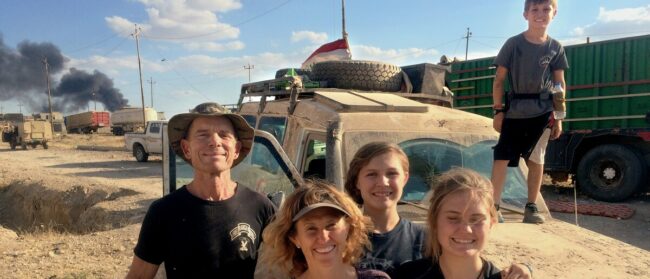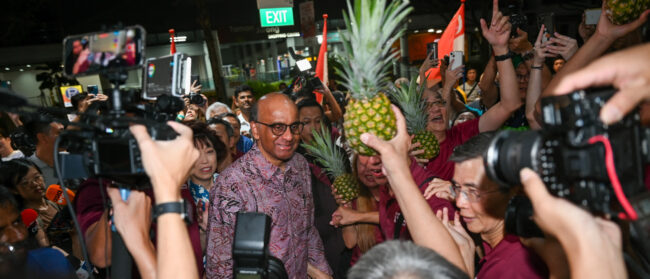Additional reporting and photography by Anton L. Delgado.
On an unbearably hot day in April, Kong Mok pantomimed wrapping a material around his neck with one hand.
Mok, 67, was on duty as a guard at the ancient Koh Ker temple complex in northern Cambodia, which was inscribed on UNESCO’s World Heritage List earlier this month. As a small group watched, Mok mimicked how he believed looters used some form of explosive to break off the valuable heads from stone statues before transporting them out of the country.
He slowly moved his other hand around his neck before shooting his arms out to both sides. Bang – no more head.
Throughout this year, far from the heat of Koh Ker, the U.S. federal government coordinated the return of illegally looted Cambodian relics from the Denver Art Museum and the private collections of billionaires as a wider reckoning in the art world has pressured collectors across the globe to give back pieces of dubious provenance.
Cambodia received 13 antiquities from the U.S. in March. Some of these had been looted from the Koh Ker complex in the grinding decades of strife that followed the Khmer Rouge regime, which collapsed in 1979 but waged insurgency until the late 1990s. These works included Hindu-era relics such as a warrior from a set of nine statues depicting a battle from the Mahabharata epic, a sandstone figure of the war god Skanda riding on a peacock and an enormous embodiment of the god Ganesha.

As foreign governments and law enforcement agencies track pilfered artefacts in their own jurisdictions, Cambodian researchers are investigating for themselves. Their work is part of a broader, often behind-the-scenes effort in the country to restore a historical legacy sold off to international dealers such as the late antiquities collector and accused smuggler Douglas Latchford.
The inquisitive group who spoke with Mok had come on behalf of the Ministry of Culture and Fine Arts with a twofold purpose – to patch together Koh Ker’s history with local narratives, however incomplete, and to track down missing pieces of ancient sculptures.
At Koh Ker, researcher Tek Soklida filmed the interview with Mok on her phone as another member of the team sat nearby, jotting details in a notebook. Senior researcher Chhoun Kunthea led the interview and interpreted for Bradley J. Gordon, a U.S. attorney representing the Ministry of Culture and working on the project.

For Soklida, the work wasn’t just a way for her to help others understand the country’s history. She felt the sculpted figures were a way her ancestors intended to communicate with the future – in other words, with her.
“A statue is not just a stone; it’s an achievement from my ancestors, who made it,” she said. The icons show her “how hard they worked at that time, even bringing the stones to the temple and carving it into a human or animal statue to show their descendants.”
A first-time visitor to Koh Ker might see only toppled stone carvings and collapsed chamber walls, lying nearby a massive pyramid erected in the 10th century. But the research team, which has been studying the temples for years, envision the outlines of what these places looked like when they were first built.
Assisted by other historians and archeologists, the team has created original drawings and maps of the area, scrutinised photos found on Latchford’s laptop, and gathered historical details through interviews with neighbouring communities.
In their on-site interviews, the team often uses photographs to help jog residents’ memories. Now, with the recent returns, the women have a new set of photos. Before moving on to another area of Koh Ker, Kunthea pulled up a picture of the Ganesha statue, which had been presented earlier at a celebration in Phnom Penh.
Mok laughed, surprised to see the statue he remembered from childhood. He hadn’t yet heard about its return.


Later, the team hiked to the back of the central structure in the complex, a seven-tiered pyramid standing more than 35 metres tall. There, Kunthea found another guard with whom she had previously spoken. Often, the team gradually gets to know people before meeting again with more explicit questions about looting.
“The information, it is not easy to get it … We try step by step to get more and more,” she said. “The questions [have to] be careful. Sometimes it’s not direct, a little bit around, and then you get to the main point of what you want to know.”
The guard, 68-year old Run Ran, suspected he was one of the oldest living villagers from Koh Ker.
Around 1980 he worked to clear the temple grounds for a time under the direction of Ta Mok, a senior leader of the Khmer Rouge nicknamed “the Butcher” for overseeing mass killings. After living near and working at the site for many years, Ran was sure he had a connection with the temple in his past lives.
The guard told the researchers he remembered seeing the complex’s 10th-century dancing Shiva statue when it still had three intact faces of its original five. Shattered into more than 10,000 pieces, the seven-tonne piece is now undergoing restoration in Siem Reap. French archeologists had moved two of the heads and some other fragments to Phnom Penh before the 1970s. And while a third face was shattered before looters got it, the remaining two heads were likely looted during the early 1990s and are still missing.
After Kunthea tried to pin down when exactly Ran had seen the statue with three heads, which would help in understanding the timeline of the looting, the women were ready to move on to Koh Ker village, where they hoped to talk with more elders.
The temple guard lamented before they left that those most knowledgeable about the statues had already died.

Even when foreign museums have returned pieces to Cambodia, such institutions don’t always offer up all of the information or documentation that could shed light on the journey the piece took, according to U.S. attorney Gordon. Without more official information, he said details from fragmented interviews, such as the ones gathered by the team at Koh Ker, are key to tracing the supply chains of looted relics.
“There’s a very small number of experts out there on Cambodia,” he explained. “They have their theories and they are doing their research, but we’re still at a point that we haven’t been able to connect the dots yet. We’re getting lots of individual pieces of the past. The question is: what does it all add up to? Why was this here?”
Despite the rounds of returns, many pieces are still missing or outside the country. A standing female deity on display at New York’s Metropolitan Museum of Art is thought to be originally from the Koh Ker.
Back in the village far from the galleries of Manhattan, the team of Cambodian researchers spoke to some older women sitting under a wooden home raised on stilts.
Yeam Koun and her niece Deb Sem, both 63, remembered seeing the set of nine warrior statues before several were looted. Sem said she remembered the area because a family member was bitten by a tiger there. At least one of these statues has still yet to be identified and brought back to Cambodia. The women suggested the team meet up with another older man in the village who might know more.

The research team stopped at a few more places in search of the village elder. They found his son-in-law, who told them to try looking for the man at a nearby pagoda. The team wasn’t able to track him down, and decided to end their research for the day.
But spirits were not low. The team made new connections and dug up new details. Plus, they had already received a tip with names of Thai families who may have received the missing looted dancing Shiva heads.
The team plans to travel to Thailand this year to follow the trail of the heads. Though plenty of investigation remains ahead, efforts such as theirs are slowly, finally bringing home the lost relics of Cambodia.


